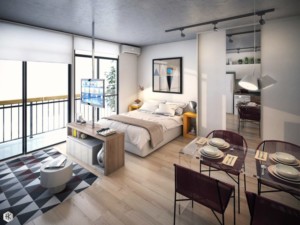
In Feng Shui practice, we need to distinguish between a yin or yang activity in order to know how best to treat a room. Yin activities include sleeping or meditation. Yang activities include any type of work or socializing. One of the most common considerations is a bedroom used in a house for sleeping versus a home office. As well, in the bigger picture a house would be considered more yin and a commercial establishment would be more yang.
Even though the unseen influences (flying stars) will be the same, they are treated differently based on the function of the room. For those familiar with the Flying Star School, Xuan Kong Fei Xing, we pay more attention to the mountain star in a sleeping room and a water star in a wakeful room. The word “star” here refers to energies which form the magnetic field of the room. And that magnetic field was created in the room based on when it was built.
In layman terms, we could look at other common sense examples of how a room may be appropriate for one function and not another. For instance, a room which is on the dark side may be fine for a sleeping room, but considered too dark or somber for an office space. A room that is near the street and some sounds of traffic may also be appropriate for an office, but not a sleeping room.
Within a two-story house, it is common to see a sleeping room directly over a wakeful room, where the identical flying stars are treated differently. The treatments for these rooms can include which elements to add organically, such as furnishings made of wood or metal. The treatment may also have to do with altering the height and distribution of the furnishings depending on the function of the space.
Not all rooms are created equal in other words, and knowing this reveals the difference between a new practitioner and a highly trained or experienced one. That said, there will be some energy in a room which will affect the occupant whether they are asleep or awake. For example, a house which faces magnetic west @ 255 degrees and built in 1934 will have energies in the back left hand room associated with bone or muscle problems. This could manifest whether the room was used as an office or bedroom. It could even affect a person if that location had a frequently used back door.
But the fine-tuning of how to deal with these similar energies will be partially reliant on how the room is used. Over long periods, the energies of a room may remain if no radical remodeling or expansion takes place.
But the interpretation of those same energies will change slowly over the decades. With the previous example of the room which could cause bone or muscle problems, for advanced Feng Shui practitioners, they know this is a combination of 8 mountain dragon and 3 water dragon. Many decades ago, the 8 star was not in good phase and could even more surely indicate potential for skeletal or musculature pains, injuries or even deformities. And yet right now, in Period 8 (2004-2023), this room would actually have potential to be one of the best rooms in that type of house. An example of a simple remedy for that particular room could be a bold display of the fire element. This could be a large red surface area, like a burgundy bed spread or a large red rug in an office. Use of high intensity lighting can also work as the fire element.
There is also the dilemma of what to do with a room that is used for more than one function, especially if one activity is “yin” and the other is “yang.” A classic example is the bedroom with a home office desk in it. Another example is the studio apartment which is all one space for sleeping as well as wakeful activities. These are special case studies, where we have to find out what a person’s priorities are or what problems they may be having.
Author: Kartar Diamond
Company: Feng Shui Solutions ®
From the Feng Shui Theory Blog Series
